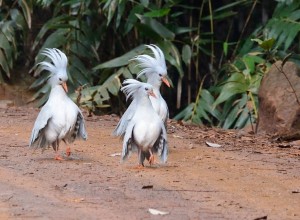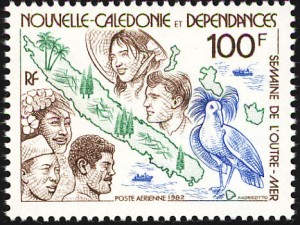The Kagu is surely one of the most wonderful birds that you may not have had the opportunity to see yet. Looking a bit like a cross between a pigeon and a court-jester, Kagus are not particularly closely related to any other species of bird. They are found only in the rainforests of New Caledonia, an island-nation far off the east coast of Australia. The Kagu is an essentially flightless bird, and so they spend their days running through the undergrowth in search of earthworms which make up the bulk of their diet.
The climate of New Caledonia is not particularly seasonal, and so birds can breed throughout the year. When Kagus get around to breeding, the reproductive pair are assisted by one or more helpers. Despite this help, only one egg is produced in each breeding attempt. Kagu chicks leave the nest just three days following hatching, after which they receive two months of care from the attending adults. The good news is that Kagus have a stable population. The bad news is that they are listed as endangered, a result of a small global population and a limited range.
Jörn Theuerkauf of the Polish Academy of Sciences and his colleagues from institutes in Japan, Germany, the United States, and New Caledonia recently published the results of a study that investigated a peculiar aspect of the Kagu’s biology. It seems that at least one-third of New Caledonia has ultramafic soils. I dashed to the dictionary so that you don’t have to. Ultramafic soils are the results of weathering of igneous rock, and have particularly high concentrations of magnesium and iron. It doesn’t stop there; ultramafic soils can be expected to have high concentrations of other heavy metals such as vanadium, chromium, copper, nickel, mercury, and selenium. Many of these elements are essential to the health of Kagus, as they are to the health of humans, but only in trace quantities. If ingested quantities become too high, impaired health can be expected.
Between 2003 and 2012, Theuerkauf and his colleagues followed the breeding biology of twelve Kagu families in Parc Provincial de la Rivière Bleue where the soils are ultramafic, and seven families in Parc Provincial dess Grande Fougères where the soils do not contain high levels of heavy metals. Individual birds were tracked using radio transmitters and activity sensors. The researchers sought out nests, and videotaped breeding activities. Heavy metals can be sequestered in feathers, and so the team collected feathers from birds and analyzed the concentrations of twenty-seven different elements, from arsenic to zinc.
Not surprisingly, feathers collected from Kagus in the region with ultramafic soils had greater quantities of some heavy metals than feathers from birds in the spot with non-ultramafic soils. The former feathers had, for instance, thirty-one times more chromium, and nine times more cobalt than the latter feathers.
Furthermore, the reproductive output of Kagus in the provincial park without ultramafic soils was four times higher than those birds living on land with soil high in heavy metals. This latter result was almost entirely the result of the former birds laying more eggs in each season. Other aspects of the breeding biology, such as the mass of the eggs, and the proportion of chicks that survived, did not differ between the two spots.
That left Theuerkauf et al. to make a link between cause and effect. Why did Kagus on the heavy-metal rich soil produce fewer eggs? Given that Kagus are endangered, it would have been unethical to expose individuals to additional heavy metals, and observe the result. Were Kagus in Parc Provincial de la Rivière Bleue being poisoned by metals taken up by the earthworms that the bird feed upon? It seems not. Instead, high concentrations of heavy metals in the spot with ultramafic soils results in reduced soil fertility. This results in fewer invertebrates in the soil on which the Kagus feed. With lesser availability of food, it takes birds longer to replenish their reserves after each breeding attempt.
Work on threatened species almost always has conservation implications. In the case of Kagus, the results of the study by Theuerkauf and his team suggest that current efforts should probably be directed toward populations living in areas where the soil is not high in heavy metals. In those spots, birds are likely to grow in number more quickly.
It is through the efforts of researchers like Theuerkauf et al. that you may, one day, have the opportunity to see Kagus in the wild.
Theuerkauf, J. et al. 2017. Elevated concentrations of naturally-occurring heavy metals inversely correlate with reproductive output and body mass of the Kagu Rhynochetos jubatus. Ibis 159:580-587.
Photo credits: www.pinterest.com



